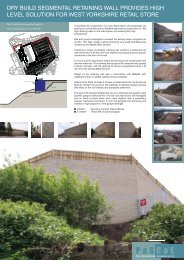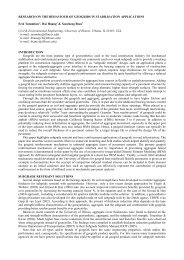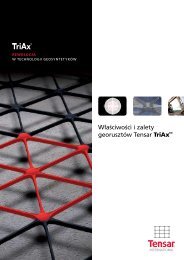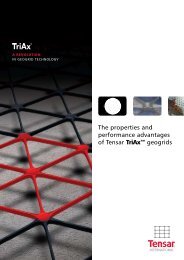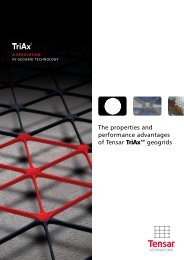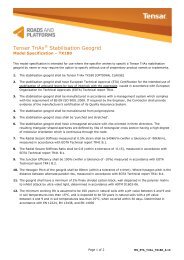3_JP Giroud_edited - Tensar International Ltd.
3_JP Giroud_edited - Tensar International Ltd.
3_JP Giroud_edited - Tensar International Ltd.
You also want an ePaper? Increase the reach of your titles
YUMPU automatically turns print PDFs into web optimized ePapers that Google loves.
Discussion of the size of geogrid apertures with respect to interlocking<br />
The ability that a geogrid has to interlock with a given aggregate depends, among other factors, on the size of the<br />
geogrid apertures and the size and grading of aggregate particles. It has been known since the first uses of biaxial<br />
geogrids that there should be an appropriate match between the size of the geogrid apertures and the size of the<br />
aggregate particles (Jewell et al. 1984). As a simple rule, the geogrid aperture size is often selected as a certain<br />
fraction of the aggregate maximum particle size.<br />
The phrase “aperture size” implies that a geogrid aperture can be characterized by one dimension, i.e. it is square<br />
or equivalent. More attention should be paid to the definition of the aperture size for apertures other than square such<br />
as: rectangular apertures; triangular apertures; and, more generally, apertures of future geogrids with innovative<br />
geometry. Also, research work should be undertaken to develop more sophisticated rules, e.g. rules that involve not<br />
only one aggregate particle size, but several characteristics of the particle size distribution curve of the aggregate.<br />
Discussion of the shape of geogrid apertures with respect to interlocking<br />
The ability that a geogrid has to interlock with a given aggregate depends, among other factors, on the relative<br />
geometry of the geogrid and the aggregate, i.e. the relationship between the shape of the geogrid apertures and the<br />
arrangement of aggregate particles. Describing aggregate arrangement is difficult. Traditionally, in soil mechanics,<br />
arrangements of identical spheres are used as a tool to understand arrangements of particles. Aggregate performs<br />
better if it is denser. The densest arrangement of identical spheres is the hexagonal arrangement and the least dense<br />
arrangement of identical spheres that are in contact together is the cubic arrangement. It may be speculated that a<br />
biaxial geogrid may tend to cause the aggregate to adopt locally a cubic arrangement in the vicinity of the geogrid,<br />
which is a loose arrangement for the aggregate, thereby limiting the benefit of interlocking. Then, at a certain distance<br />
from the geogrid, the aggregate may recover an arrangement that is more or less hexagonal (assuming that the<br />
aggregate has been placed in a dense state, i.e. has been well compacted). However, the transition in structure and<br />
density, from the cubic arrangement in the vicinity of the geogrid to the hexagonal arrangement away from the<br />
geogrid, is probably not favorable to optimum mechanical behavior of the aggregate. In contrast, a geogrid that<br />
interlocks with a dense aggregate without disturbing the arrangement of the aggregate is likely to be most beneficial to<br />
an aggregate that has been well compacted. (Incidentally, research on the impact of compaction on interlocking would<br />
be useful.) The discussion based on arrangement of spheres only provides an approximate description of the<br />
interlocking mechanism between aggregate and geogrid. Therefore, rather than “without disturbing the arrangement”,<br />
it is preferable to say “with minimum disturbance of the arrangement”.<br />
The above discussion seems to lead to the conclusion that a geogrid should have a hexagonal structure in order to<br />
interlock with a dense aggregate (i.e. a well compacted aggregate having an approximately hexagonal arrangement)<br />
with minimum disturbance of its arrangement. In fact, there are two planar structures that may meet the condition of<br />
interacting with a dense aggregate while causing minimum disturbance of its approximately hexagonal arrangement: a<br />
geogrid with hexagonal apertures and a geogrid with apertures having the shape of equilateral triangles.<br />
Both a geogrid with hexagonal apertures and a geogrid with apertures having the shape of equilateral triangles may<br />
interlock with a dense aggregate while causing minimum disturbance of its arrangement. However, there is a major<br />
difference between a geogrid with hexagonal apertures and a geogrid with apertures having the shape of equilateral<br />
triangles. In a geogrid with apertures having the shape of equilateral triangles, the ribs are aligned, whereas, in a<br />
geogrid with hexagonal apertures, the ribs are not aligned. If the ribs are aligned, the tensile characteristics of the<br />
geogrid are higher. Furthermore, if the ribs are aligned, it is possible to manufacture a geogrid with stretched<br />
(“drawn”) ribs, which provides tensile characteristics that cannot be achieved without drawing.<br />
It should be noted that the above discussion is only speculative and qualitative. The only purpose of this discussion<br />
is to suggest topics for research work aimed at providing a quantitative analysis of interlocking. Also, the above<br />
discussion is limited to the aggregate arrangement. It is likely that the shape of the aggregate particles has an impact<br />
on interlocking with geogrids. This is also a suggested subject for future research.<br />
Discussion of the shape and stiffness of ribs with respect to interlocking<br />
The shape and stiffness of ribs can be expected to play a key role in the development of interlocking between a<br />
geogrid and aggregate. Since interlocking is likely to play a key role in the behavior of unpaved roads and unpaved<br />
areas, it can be said that the shape and stiffness of ribs are likely to play a key role in the behavior of unpaved roads<br />
and unpaved areas.<br />
As pointed out previously in this paper, efficient geogrid-aggregate interlocking requires that the relative<br />
displacement between the geogrid and aggregate be small. It may be assumed that a geogrid should be stiff to act with<br />
small displacement. However, if a geogrid is too stiff, it may disturb the aggregate structure during aggregate<br />
placement or it may lack strain compatibility with the aggregate, thereby disturbing the aggregate during the first<br />
application of a load. As a result, a geogrid that is too stiff could be detrimental or its benefits could be limited.<br />
Regarding the shape of the geogrid ribs, two considerations are the height and the thickness of the ribs. For<br />
example, in the case of extruded geogrids (geogrids that rely essentially on interlocking with aggregate) it is thought<br />
that ribs should be: (i) thin (at least as thin as compatible with the required stiffness) in order to cause minimum<br />
disturbance to the aggregate; and (ii) tall (in the direction perpendicular to the plane of the geogrid) to maximize



